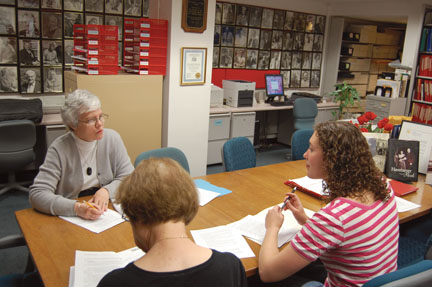Telling Tales in Greenwich
Oral historian Cathy Hyder Ogden ’67 records a town’s past as told by those who lived it.
On June 27, 1983, Cathy Hyder Ogden drove across the Mianus River on Interstate 95 in Coscob, Conn., with her 6-year-old son in the car. At 1:30 the next morning, the bridge collapsed, plunging two tractor-trailers and two automobiles into the river, 100 feet below. Three people were killed.
Luckily for historians, the bridge disaster occurred in Greenwich, Conn., home of the Greenwich Library Oral History Project. Ogden, an oral historian, and fellow volunteers documented the disaster in a book that contains 15 interviews, including the police officer who arrived first at the scene, three survivors, several bridge engineers, and the governor. Shoddy state road maintenance and inspections turned out to be the culprit, and, today, engineering schools across the country request copies of the book The Mianus River Bridge Collapse, June 28, 1983.
The Oral History Project started in 1973 and has captured town memories from the 1890s to the present day. Although the Mianus River Bridge book garners interest from around the United States, the group’s most popular book is Tod’s Point, which explores the history of the local town beach. The project publishes one to two books a year. Their most recent title profiles the local arts and science museum: The Bruce Museum—A Century of Change.
Today, the Friends of Greenwich Library raises funds to power the all-volunteer effort. So far, the team has collected more than 800 interviews and published 135 books, which circulate in local libraries and can be bought on the Web. (Visit www.glohistory.org for more information.)
Ogden adores oral history. She began volunteering in 1981 and now chairs the organization. “Oral history brings you an immediate sense of the past,” says Ogden. Her favorite story comes from The 1938 Hurricane of Willowmere, in which a young boy describes how he rescued his friend from the horrific floods. “He tells how he watched a dining room table with lighted candles floating by. When you read that interview, you’re right there with him,” she says.
Townsfolk volunteer to be interviewed for the Greenwich project, but Ogden and her crew can’t get to them all. She gives priority to citizens in their 80s and 90s as well as to story topics that haven’t been well-
covered. The Oral History Project tries to record all major trends to paint a true picture of the town. In the 1970s, many corporate headquarters moved to Greenwich. In the 1980s, there was an influx of Japanese families. The project also documents the era of great family estates in the early 20th century, the disappearance of fishing and farming in the community, and how little villages were absorbed as the town grew. Soon, Ogden says, the project will begin documenting the current economic downswing.
One interview with Nancy Carnegie Rockefeller tells how she opened a birth control clinic in town in defiance of state law. Another documents how a man named Prince James Stuart kept a privy council and claimed he was the true heir to the British throne. But most focus on regular folk, such as shopkeepers, policemen, teachers, homemakers, and immigrants. “We can really document people who are forgotten,” says Ogden. “Everyone has a story.”
At Swarthmore, Ogden majored in art history and always loved English literature. She moved to Greenwich when she married Ross Ogden ’66, and they raised their family there. An ad looking for volunteer editors lured her into the project, and she was hooked.
Ogden is not the only Greenwich oral historian with ties to Swarthmore. The late Olwen Jones ’43, Barbara Muller Ornstein ’49, and Patricia Cotton Isbrandtsen ’43 all worked on the project. It’s easy to see the draw for Swarthmore graduates. The oral history volunteers add in rigorous academics as they index each interview and transcript with searchable key words. This thorough indexing improves access for researchers. Indexing and prolific book publishing help make the Greenwich Oral History Project quite unique, says Ogden.
After 28 years, Ogden still loves the mix of fun and scholarship. She laughs at tales of a boy who was sent to the local store to fill a jug of beer for his dad and an early–20th-century livery-stable owner who predicted cars would never catch on. The livery-stable site is now a Lexus dealership. “You have to like the academic side of the work,” she says. “But it’s also so warm and funny.”
 Email This Page
Email This Page
